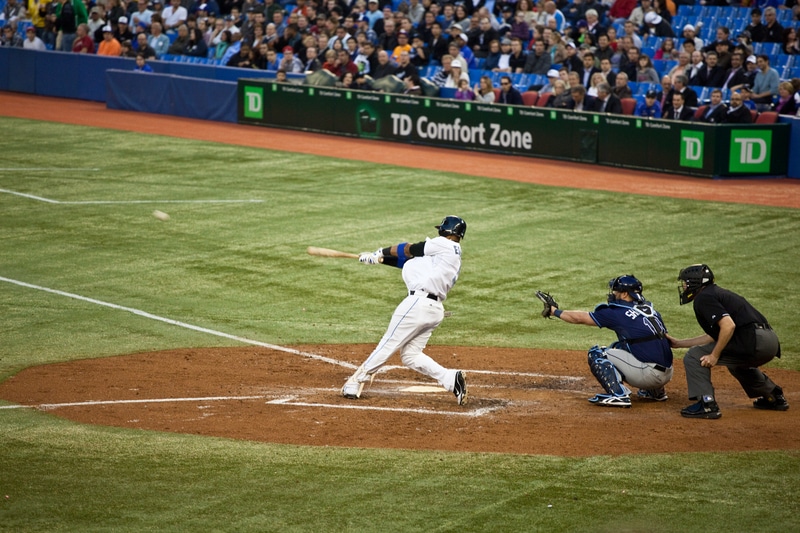Last updated on October 26th, 2023 at 12:09 pm
The slugging percentage emphasizes the number of bases a hitter gets against the total number of at-bats at the plate. A single is worth one point, a double is two points, a triple is three points, and a home run is four. The more bases a base hit produces, the more value there is in a player’s slugging percentage.
Single= 1 point
Double= 2 points
Triple = 3 points
Home Run = 4 points
You can simplify this by thinking of everything as a fraction. It is the total number of bases you got against the total number at bats. So, for example, a player hits a homerun and gets four bases on that swing. The other three times they strike out, so there total is 4/4, which means a slugging percentage of 1.0 If they only had three at bats with one home run and two strikeouts, the slugging percentage would be 1.33
What is the Formula for Baseball Slugging Percentage?
SLG = (1B + 2B*2 +3B*3 +HR*4) / TAB (Total At Bats)
Let’s suppose a made-up player’s slugging percentage for a season. They had 450 at-bats, 90 singles, 35 doubles, 2 triples, and 15 home runs. With this information, you would input their numbers to determine their slugging percentage for that season. The answer to this made-up scenario is that this hitter had a .502 slugging percentage
Slugging Percentage = (90 + 35*2 +2*3 + 15*4) = 226. Then take 226 and divide that into 450, and you get .502 as a slugging percentage.
Who Has the Highest Slugging Percentage in a Single Season in MLB History?
According to Baseball Reference, Josh Gibson has the highest slugging percentage, with a .9744 in 1937. He, as of 2023, is on the top 10 list two other times. Here is a list of some of the highest slugging percentages in MLB history.
- Josh Gibson: .9744 (1937)
- Mule Suttles: .8771 (1926)
- Charlie Smith: .8699 (1929)
- Josh Gibson: .8675 (1943)
- Barry Bonds: .8634 (2001)
- Babe Ruth: .8472 (1920)
Why is Slugging Percentage a Good Baseball Statistic
Using slugging percentage (or the slugging average) to gauge a minor league or Major League baseball player is an excellent way to evaluate their power. Since slugging percentage gives importance to the more bases a player can get via a base hit, teams can use this metric to separate hitters who might get on base via luck or with weak singles from hitters who hit the ball with authority.
When you combine slugging percentage with other metrics, like on-base percentage, to create the on-base plus slugging percentage (OPS), you can understand what a batter can produce in more detail.
Why is Slugging Percentage a Bad Baseball Statistic
One knock-on slugging percentage is that it doesn’t factor in getting on base via walks, intentional walks, or a hit-by-pitch. Some players are better at working the count to get on base via a walk, which this formula does not consider. When you factor in players who are getting intentionally walked, slugging percentage completely misses this factor.
For example, Barry Bonds had 120 intentional walks during his 2004 season. Teams purposely walked Barry Bonds because of how often he would hit home runs that season. With that said, you wouldn’t get the complete picture of how dominant his 2004 season was because his slugging percentage would overlook the walks he had, which is why adding that metric to the on-base percentage is a must.
Another issue of slugging percentage is that it omits sacrifice flies and sacrifice bunts from the formula. That means a player who hit a fly ball out and drove in a run won’t receive credit on their slugging percentage number.
How Does the Slugging Percentage Differ from Batting Average?
The slugging percentage formula calculates the number of bases a hitter got against the number of at-bats at the plate. The slugging percentage gives more weight to any other type of hit over the number of singles that a player got. For instance, a double is worth two times more than a single in the formula. A triple is worth three times as much as a single, and a homerun is four times.
On the other hand, the batting average of hitters takes a straightforward approach to create a simple statistic. The batting average counts singles and home runs as the same value, so as long as a batter got a successful base hit, you take that number and divide it against their plate appearances. That means a hitter who went 1-4 with a home run and another who went 1-4 with a single would have a .250 batting average. However, one player had more value with their hit than the other, but the batting average would be the same.
Conclusion: What is Slugging Percentage in Baseball / What is Slugging in Baseball?
In summary, a slugging percentage in baseball measures the number of bases a hitter gets from base hits against their total number of at-bats. The idea behind the SLG formula is to give more value to getting a double over a single, a triple over a double, and so on. By giving more importance to an extra-base hit, or a home run, you can get a better feel for the value of what a hitter usually produces at a plate.
However, it is worth noting that there are flaws in the formula, which is why baseball fans should look at the slugging percentage as only one metric. Slugging does not count walks, hit-by-pitches, or sacrifice hits into the equation. That means the formula does not give any credit for a player getting on base via intentional walks like Barry Bonds did 120 times during the 2004 season.
Similar Posts:
What Does BABIP Mean in Baseball?
What to Wear to a Baseball Game
How Long is a Minor League Baseball Game?
What Does ERA Mean in Baseball?
What Does WHIP Mean in Baseball?
What is the Bullpen in Baseball?
What is a Batting Average in Baseball?
What is the Strike Zone in Baseball?
What is a Perfect Game in Baseball?
What Does FIP Mean in Baseball?
What is a Doubleheader in Baseball?
What is a Bullpen Game in Baseball?
Greg Kristan, owner of The Stadium Reviews, LLC and TM Blast, LLC, brings his extensive experience visiting over half of the MLB ballparks, along with numerous MLS, NHL, NBA, and NFL venues, to provide in-depth coverage on the bag policy, food options, and parking. He has also been interviewed about his experiences on several sports podcasts.







